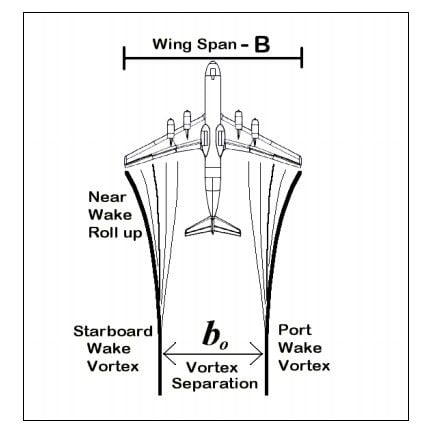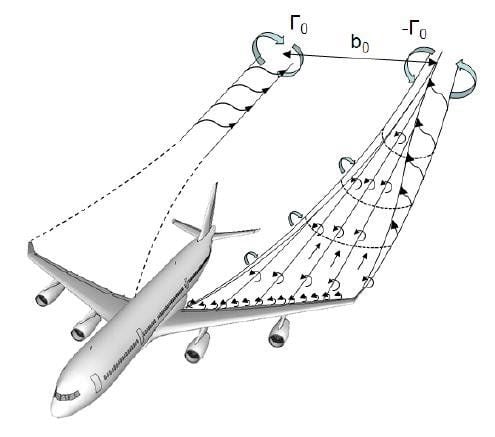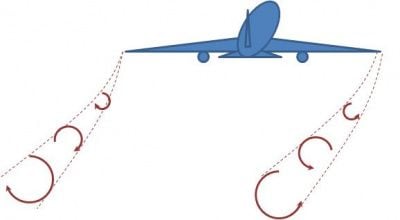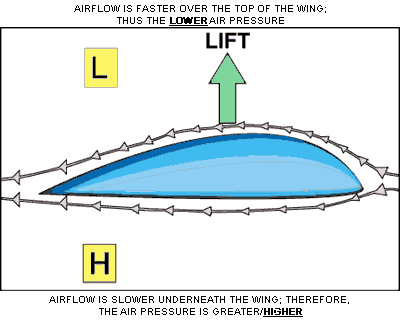One for the aerodynamicists, I think
Thread Starter
Join Date: Jun 2001
Location: Wherever someone will pay me to do fun stuff
Posts: 1
Likes: 0
Received 0 Likes
on
0 Posts
One for the aerodynamicists, I think
Over the years I have read lots of documents about wake turbulence, most containing dire warnings of the risks associated with their presence. Almost every one talks about vortices being generated (on take-off) from the point of rotation, described often from what I recall as the point when the wing starts generating lift.
I really don't know much about how wings work but to my simple mind, as soon as the wing moves through the air around it has the potential to generate a vortex at the tip as the air going over and under the wing meets. Clearly, more significant vortices will be generated as speed increases, and they may not be a practical threat to other aircraft until rotation or thereabouts but it seems to me that it is incorrect to say that they are not generated until the wing produces lift (or something similar). Or am I wrong?
This is not completely an academic question - in the context of training a newly-minted air traffic controller I was asked a question about clearing a helicopter to cross a runway behind a departing aircraft. After dealing with jet blast and the like, there was a residual thought in my mind about the risk of the helicopter encountering wake vortex disturbances.
Any expert input welcome.
I really don't know much about how wings work but to my simple mind, as soon as the wing moves through the air around it has the potential to generate a vortex at the tip as the air going over and under the wing meets. Clearly, more significant vortices will be generated as speed increases, and they may not be a practical threat to other aircraft until rotation or thereabouts but it seems to me that it is incorrect to say that they are not generated until the wing produces lift (or something similar). Or am I wrong?
This is not completely an academic question - in the context of training a newly-minted air traffic controller I was asked a question about clearing a helicopter to cross a runway behind a departing aircraft. After dealing with jet blast and the like, there was a residual thought in my mind about the risk of the helicopter encountering wake vortex disturbances.
Any expert input welcome.
Join Date: May 2000
Location: Seattle
Posts: 3,195
Likes: 0
Received 0 Likes
on
0 Posts
The more lift created, the stronger the vortices.
Technically, the vortices may be generated earlier in the takeoff roll, since most airplane wings have a positive angle of incidence/attack when on the ground. However, they become MUCH stronger at rotation when the wings start lifting the entire airplane and the airplane starts climbing. During rotation, the wings go from producing enough lift to raise the wingtips, to more than enough lift to carry the airplane, all in 2-3 seconds.
Technically, the vortices may be generated earlier in the takeoff roll, since most airplane wings have a positive angle of incidence/attack when on the ground. However, they become MUCH stronger at rotation when the wings start lifting the entire airplane and the airplane starts climbing. During rotation, the wings go from producing enough lift to raise the wingtips, to more than enough lift to carry the airplane, all in 2-3 seconds.
Moderator
It all commences at the start of the takeoff roll with the starting vortex. PPRuNe's resident aerodynamicist, Owain Glyndwr, has numerous words to say on circulation which is the buzzword you seek. Our other aerody guru, djpil, likewise, may have some comments on the topic as well.
Also have a read of Gentry's articles at
Gentry Sailing | Theory and Practice
You might, in particular, have a read of Gentry's Origins of Lift at http://www.gentrysailing.com/pdf-the...ns-of-Lift.pdf
Also have a read of Gentry's articles at
Gentry Sailing | Theory and Practice
You might, in particular, have a read of Gentry's Origins of Lift at http://www.gentrysailing.com/pdf-the...ns-of-Lift.pdf
To elaborate a bit on what Intruder wrote:
The wing tip vortex is, in very simple terms, the high pressure air below the wing trying to displace the low pressure air above the wing. Since it's the difference in air pressure between the top and bottom of the wing that creates lift, although there are various methods of disguising or decreasing the strength of that vortex (e.g. winglets), as long as the wing is creating lift the vortex will exist. The greater the lift, the greater the pressure differential between the top and the bottom of the wing, and the stronger the resultant vortex. So, as a general rule, the heavier the aircraft, the stronger the vortex.
To your specific example, jet wakes dissipate fairly quickly - even at takeoff thrust, the jet wake will be down to around 35 knots only 300 meters (1000 ft.) behind the aircraft. The wing tip vortices can take upward of a minute to dissipate to a safe level.
The wing tip vortex is, in very simple terms, the high pressure air below the wing trying to displace the low pressure air above the wing. Since it's the difference in air pressure between the top and bottom of the wing that creates lift, although there are various methods of disguising or decreasing the strength of that vortex (e.g. winglets), as long as the wing is creating lift the vortex will exist. The greater the lift, the greater the pressure differential between the top and the bottom of the wing, and the stronger the resultant vortex. So, as a general rule, the heavier the aircraft, the stronger the vortex.
To your specific example, jet wakes dissipate fairly quickly - even at takeoff thrust, the jet wake will be down to around 35 knots only 300 meters (1000 ft.) behind the aircraft. The wing tip vortices can take upward of a minute to dissipate to a safe level.
Of course, any frontal airflow over a wing will produce lift (assuming the wing is cambered and not at a negative AoA). The lift produced scales with half of the square of the airspeed (the equation is a bit more complicated, but L = (1/2 v^2 ) is still in there).
A little messing around with a decent aerodynamics sim (which has the advantage of being able to give me "weight on wheels" as a value) shows me that with a B717 at MTOW 110,000 lbs, flaps 13:
Lined up in a 9-knot headwind, the wind alone was producing 200 lbs of lift. (the weight on wheels is 200 lbs less than actual weight).
Accelerated to 50 kts IAS, the lift was 7000 lbs
At 100 kts the lift was 17000 lbs
At 150 kts the lift was 52000 lbs
And of course at lift-off the lift must be at least the weight of the aircraft - ~110,000 lbs minus a little fuel weight burned on the TO run. I say "at least" because at rotation and shortly therafter, when the vertical speed is accelerating from, say, zero to 1800 fpm, lift > weight.
One can say the lift is increasing rapidly with speed - but equally, will still be a rather low percentage of the final lift needed to get off the ground - until AoA is increased in the rotation, which at least doubles the lift (and thus the force behind the vortex, although there may be a proportional factor in there as well).
Clear a helicopter to pass behind that (hypothetical) B717 at the point the B717 was passing 100 kts, and the vortex may be only about the same as that generated by a B1900 turboprop at lift-off (~17000 lbs, also at ~100 kts, coincidentally).
Note also that ground-effect has a suppressing effect on wing vortices - they are generally about 30% less forceful than at the same speed/weight/etc. in free air.
A little messing around with a decent aerodynamics sim (which has the advantage of being able to give me "weight on wheels" as a value) shows me that with a B717 at MTOW 110,000 lbs, flaps 13:
Lined up in a 9-knot headwind, the wind alone was producing 200 lbs of lift. (the weight on wheels is 200 lbs less than actual weight).
Accelerated to 50 kts IAS, the lift was 7000 lbs
At 100 kts the lift was 17000 lbs
At 150 kts the lift was 52000 lbs
And of course at lift-off the lift must be at least the weight of the aircraft - ~110,000 lbs minus a little fuel weight burned on the TO run. I say "at least" because at rotation and shortly therafter, when the vertical speed is accelerating from, say, zero to 1800 fpm, lift > weight.
One can say the lift is increasing rapidly with speed - but equally, will still be a rather low percentage of the final lift needed to get off the ground - until AoA is increased in the rotation, which at least doubles the lift (and thus the force behind the vortex, although there may be a proportional factor in there as well).
Clear a helicopter to pass behind that (hypothetical) B717 at the point the B717 was passing 100 kts, and the vortex may be only about the same as that generated by a B1900 turboprop at lift-off (~17000 lbs, also at ~100 kts, coincidentally).
Note also that ground-effect has a suppressing effect on wing vortices - they are generally about 30% less forceful than at the same speed/weight/etc. in free air.
Avoid imitations
Join Date: Nov 2000
Location: Wandering the FIR and cyberspace often at highly unsociable times
Posts: 14,573
Received 422 Likes
on
222 Posts
The usual "separation for wake turbulence" applied by ATCOs to helicopters is often "by the book" and very much on the over-cautious side (not a criticism).
Vortices formed by aircraft tend to descend and obviously, they also drift away with the wind so it's relatively easy for an experienced helicopter pilot to avoid them.
Vortices formed by aircraft tend to descend and obviously, they also drift away with the wind so it's relatively easy for an experienced helicopter pilot to avoid them.
Another unrelated but relevant aspect is that helicopters also produce a wake that can be dangerous to light aircraft. A former student of mine died in an accident at Oxford when his SEP encountered the wake of a large helicopter (S61?) in the hover near the threshold.It was about 30 years ago, but I have been unable to find any details online.
Another unrelated but relevant aspect is that helicopters also produce a wake that can be dangerous to light aircraft. A former student of mine died in an accident at Oxford when his SEP encountered the wake of a large helicopter (S61?) in the hover near the threshold.It was about 30 years ago, but I have been unable to find any details online.
Report on the accident to Piper PA-28-161 Cadet, G-BPJT at Oxford Airport, Kidlington on 12 July 1992
Join Date: Mar 2006
Location: USA
Posts: 2,515
Likes: 0
Received 0 Likes
on
0 Posts
Of course, any frontal airflow over a wing will produce lift (assuming the wing is cambered and not at a negative AoA). The lift produced scales with half of the square of the airspeed (the equation is a bit more complicated, but L = (1/2 v^2 ) is still in there).
A little messing around with a decent aerodynamics sim (which has the advantage of being able to give me "weight on wheels" as a value) shows me that with a B717 at MTOW 110,000 lbs, flaps 13:
Lined up in a 9-knot headwind, the wind alone was producing 200 lbs of lift. (the weight on wheels is 200 lbs less than actual weight).
Accelerated to 50 kts IAS, the lift was 7000 lbs
At 100 kts the lift was 17000 lbs
At 150 kts the lift was 52000 lbs
And of course at lift-off the lift must be at least the weight of the aircraft - ~110,000 lbs minus a little fuel weight burned on the TO run. I say "at least" because at rotation and shortly therafter, when the vertical speed is accelerating from, say, zero to 1800 fpm, lift > weight.
One can say the lift is increasing rapidly with speed - but equally, will still be a rather low percentage of the final lift needed to get off the ground - until AoA is increased in the rotation, which at least doubles the lift (and thus the force behind the vortex, although there may be a proportional factor in there as well).
Clear a helicopter to pass behind that (hypothetical) B717 at the point the B717 was passing 100 kts, and the vortex may be only about the same as that generated by a B1900 turboprop at lift-off (~17000 lbs, also at ~100 kts, coincidentally).
Note also that ground-effect has a suppressing effect on wing vortices - they are generally about 30% less forceful than at the same speed/weight/etc. in free air.
A little messing around with a decent aerodynamics sim (which has the advantage of being able to give me "weight on wheels" as a value) shows me that with a B717 at MTOW 110,000 lbs, flaps 13:
Lined up in a 9-knot headwind, the wind alone was producing 200 lbs of lift. (the weight on wheels is 200 lbs less than actual weight).
Accelerated to 50 kts IAS, the lift was 7000 lbs
At 100 kts the lift was 17000 lbs
At 150 kts the lift was 52000 lbs
And of course at lift-off the lift must be at least the weight of the aircraft - ~110,000 lbs minus a little fuel weight burned on the TO run. I say "at least" because at rotation and shortly therafter, when the vertical speed is accelerating from, say, zero to 1800 fpm, lift > weight.
One can say the lift is increasing rapidly with speed - but equally, will still be a rather low percentage of the final lift needed to get off the ground - until AoA is increased in the rotation, which at least doubles the lift (and thus the force behind the vortex, although there may be a proportional factor in there as well).
Clear a helicopter to pass behind that (hypothetical) B717 at the point the B717 was passing 100 kts, and the vortex may be only about the same as that generated by a B1900 turboprop at lift-off (~17000 lbs, also at ~100 kts, coincidentally).
Note also that ground-effect has a suppressing effect on wing vortices - they are generally about 30% less forceful than at the same speed/weight/etc. in free air.
X-Plane, which uses blade-element theory to calculate aerodynamic effects "on the fly" (henh-henh  ) from the specced airfoil reynolds #, CoL, etc. And not from a priori tables.
) from the specced airfoil reynolds #, CoL, etc. And not from a priori tables.
To be taken "seriously but not literally." I have no idea how close the specced airfoil matches a real B717, but the numbers did tend to track with the equation.
 ) from the specced airfoil reynolds #, CoL, etc. And not from a priori tables.
) from the specced airfoil reynolds #, CoL, etc. And not from a priori tables.To be taken "seriously but not literally." I have no idea how close the specced airfoil matches a real B717, but the numbers did tend to track with the equation.
next time in a pool, move your hand at an angle across the surface. As it starts to move say assuming a motion from left to right, and viewed from above... with a slight positive angle to the direction of motion, a vortex will be seen behind the trailing edge location at the start of movement, and for this example it will rotate clockwise, counter to the bound vortex flow that exists around your hand. Newtonian physics indicates that the bound vortex is therefore equal & opposite, being counter clockwise. When your hand stops (a flat plate is easy to use..) a vortex is shed of the leading edge. IMHO the demonstration is the simplest analogue to explain bound vortex and the development of lift without reverting to a physical model that relies on anthropomorphic desires of molecules as the Bernoulli theory of lift needs. vortex theory is also consistent with the flow around multiple elements. Same visualisation from a tea/coffee cup, or a bowl of soup etc... Add pepper for the tomato soup case, and you have a nice little visualisation tool, use spoon then not hand, "Liquid may be Hot..."
Join Date: Nov 2015
Location: Paisley, Florida USA
Posts: 289
Likes: 0
Received 0 Likes
on
0 Posts
Don't forget that wingtip vortices are generated in all normal phases of flight, including landing. They are present on approach all the way through the landing, but are most severe prior to the main wheels touching down. Due to relatively large flap deflections involved in landing, vortices can be generated even at the low angles of attack and relatively low airspeeds of the landing roll out. As an interesting aside, I have often heard vortices overhead just short of the approach end of an active runway at MIA. They make a sound akin to the tearing of paper or light fabric, such as a sheet. Of course, the vortices can actually be seen on humid days.
Cheers,
Grog
Cheers,
Grog
Join Date: May 2005
Location: F370
Posts: 199
Likes: 0
Received 0 Likes
on
0 Posts
I would expect the helicopter to climb to at least 100’, or climb continuously as he crosses the runway. Wake turbulence will descend after it’s generated, so should be close to the ground. Therefore all the turbulence would be below his flight path. (I’m not a rotor-head at all).
Join Date: Feb 2019
Location: shiny side up
Posts: 431
Likes: 0
Received 0 Likes
on
0 Posts
First off, the wingtips to not produce the vorticies, nor is the core located at the wingtip. Wingtip vorticies are a mis-nomer, it is really a wing vortex. Like many things in avaition, they get oversimplified for the public, and it is tough to shake them loose.
Winglets have absolutely no effect on the wake. What you frequently see from the wingtip or a flap edge, is a high pressure discontinuity.
The rollup of the vortex is a function of wingspan and weight. Core velocity is terminal, so there is a maximum speed at which the core will rotate, the physics of the air simply cannot sustain a higher velocity. The core size of each vortex is a function of the wing, typically we use a half span. (of each respective wing) Thus the core velocity of the wake from a B737-800 is the same as an A380. The core size, well, there is the obvious difference. In equal conditions, the decay rate is the same, hence with a larger core, the time is longer.
A vortex has to 'rollup' to be created, hence you will see the formed vortex at approximately one wingspan above the surface. Again, one can see difference in where the A380 vs A320 vortex will be formed.
The whipcrack that one frequently hears is the center core of the vortex breakup up and going subsonic.
Near the ground, once the aircraft enters ground effect, there are no wake vorticies produced. It has no room to rollup, and of course, there is the engine thrust.
For your operations, the inversion layers will be of the most effect on the wake. These are usually thermal, rising up as the sun warms the surface. These layers can trap, bounce or hang a wake. Calm conditions with little winds and inversion layers are usually the most concerning. I have seen wakes from 737-800, that would normally last 15 seconds, hang for 4 minutes.
Another would be an overwater approach, especially when the end of the runway is near water. Water does not have the same effect on the decay rate as land/vegetation. A wake can sit there, and be held there by the inversion layer....

The current buzzword is "Bo" (B- knot) for wake vortex mechanics...the center or the vortex is at half span.

Winglets have absolutely no effect on the wake. What you frequently see from the wingtip or a flap edge, is a high pressure discontinuity.
The rollup of the vortex is a function of wingspan and weight. Core velocity is terminal, so there is a maximum speed at which the core will rotate, the physics of the air simply cannot sustain a higher velocity. The core size of each vortex is a function of the wing, typically we use a half span. (of each respective wing) Thus the core velocity of the wake from a B737-800 is the same as an A380. The core size, well, there is the obvious difference. In equal conditions, the decay rate is the same, hence with a larger core, the time is longer.
A vortex has to 'rollup' to be created, hence you will see the formed vortex at approximately one wingspan above the surface. Again, one can see difference in where the A380 vs A320 vortex will be formed.
The whipcrack that one frequently hears is the center core of the vortex breakup up and going subsonic.
Near the ground, once the aircraft enters ground effect, there are no wake vorticies produced. It has no room to rollup, and of course, there is the engine thrust.
For your operations, the inversion layers will be of the most effect on the wake. These are usually thermal, rising up as the sun warms the surface. These layers can trap, bounce or hang a wake. Calm conditions with little winds and inversion layers are usually the most concerning. I have seen wakes from 737-800, that would normally last 15 seconds, hang for 4 minutes.
Another would be an overwater approach, especially when the end of the runway is near water. Water does not have the same effect on the decay rate as land/vegetation. A wake can sit there, and be held there by the inversion layer....

The current buzzword is "Bo" (B- knot) for wake vortex mechanics...the center or the vortex is at half span.

Join Date: May 2005
Location: F370
Posts: 199
Likes: 0
Received 0 Likes
on
0 Posts
Smythe,
Thank you for that!
My personal experience with a wing vortex was when I was jogging on the perimeter road near the threshold on a light wind day (back when that was allowed). I heard the vortex before I felt it, but the experience literally blew me away. Since then I have visualized the vortex as descending from the wingtip (as the dark line in your diagram) and that has kept me out of trouble. It’s not just the public who like things simple,
Thank you for that!
My personal experience with a wing vortex was when I was jogging on the perimeter road near the threshold on a light wind day (back when that was allowed). I heard the vortex before I felt it, but the experience literally blew me away. Since then I have visualized the vortex as descending from the wingtip (as the dark line in your diagram) and that has kept me out of trouble. It’s not just the public who like things simple,
The term "wake turbulence" is used in this context to describe the effect of the rotating air masses generated behind the wing tips of large jet aircraft







